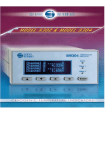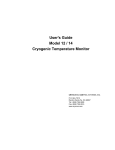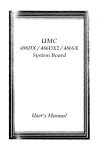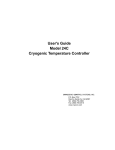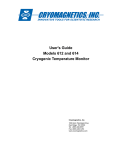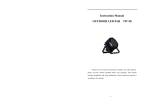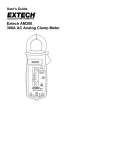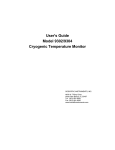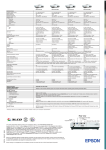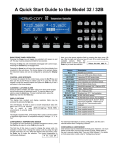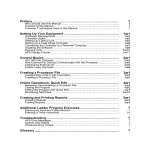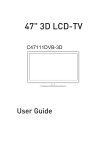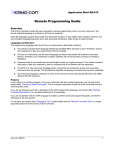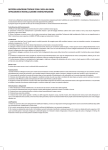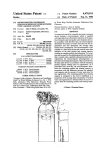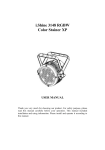Download Cryogenic Temperature Monitors
Transcript
Cryogenic Temperature Monitors Model 12 and Model 14 Two or four input channels with Ethernet connectivity Cryo-con’s Model 12 and 14 are the most flexible and accurate temperature monitors currently available. These two or four channel monitors have a level of sophistication not found in other products. Virtually any cryogenic temperature sensor from any manufacturer can be selected by a single setting of the front panel. Additional custom or specially calibrated sensors require only a simple setup procedure. In addition to its high accuracy/performance and low noise design, unique features include: ConstantVoltage AC sensor excitation, Internal Data Logging, Ethernet Connectivity, a large easy to read display and extensive utility software Ethernet connectivity adds a new dimension of utility to these monitors. In both industrial and laboratory applications, Ethernet is more reliable and easier to use compared to other communication standards. Furthermore, it is essential to remote, distributed sensor or Local Area Network based systems. • Two models available. The Model 14 has four input channels and the Model 12 has two. All channels are identical in function. • Multipurpose input channels support Diode, Platinum RTD and cryogenic NTC resistive temperature sensors. • Constant-Voltage, AC excitation of resistive sensors increases temperature range and improves sensitivity. • Analog voltage output plus two programmable dry-contact relays. • Continuous data logging into internal NonVolatile memory. • High speed Ethernet interface. Electrically isolated. • Built-in web server. Temperature monitoring and instrument configuration can be performed using any web browser. • TCP/IP User Data Socket for complete remote operation using a simple IEEE-488 like command language. • SMTP interface sends e-mail on a selected alarm condition. • LabView drivers available for both the Ethernet (TCP/IP) and serial port. Flexibility: The Model 14 has four independent and Accuracy: Measurement accuracy is obtained by identical multi-purpose sensor inputs whereas the Model 12 has two. Each can be easily configured to support virtually any cryogenic temperature sensor. Configuration is performed from the instrument’s front panel or a remote interface. There are no jumpers, trim pots or switches. using a 24-bit analog to digital conversion. Accuracy is further enhanced by extensive use of Digital Signal Processing (DSP) techniques. Silicon Diode sensors from Cryo-con or any other manufacturer are directly supported over their full 1.4 to 500K range using built-in calibration curves and sensor data. Plus, non-volatile Flash memory is available for several custom or calibrated sensors. Platinum RTD sensors can use built-in DIN 43760 (IEC 750) standard setups for 100Ω or 1,000Ω devices. The Model 12/14 uses the DIN standard for temperatures from 70K to 1020K and extends it down to 30K for cryogenic use. Operation down to about 14K is available using user supplied curves. A unique feature of these monitors is the use of a ratiometric resistance bridge technique to measure Platinum RTD sensors. This significantly reduces low frequency noise and drift to provide rock-solid measurements. These monitors provide robust support for the Negative Temperature Coefficient (NTC) sensors commonly used by cryogenic applications. They include Ruthenium-oxide, Cernox, CarbonGlass, Germanium and several others. Since they have a negative temperature coefficient, the constantvoltage measurement method will reduce, rather than increase, power dissipation in the sensor as temperature decreases. By maintaining the lowest possible power level, sensor self-heating is minimized and useful temperature range is greatly increased. An additional advantage to constant-voltage biasing is that NTC resistors lose sensitivity in the upper part of their range. By auto-ranging excitation current to maintain a constant voltage, sensitivity and noise immunity in that range is greatly improved. Sensor excitation used in conjunction with the constant-voltage feature is a 2.5Hz bipolar square wave. This effectively cancels thermal EMF induced offset errors that sometimes occur in cryogenic systems. The maximum and minimum sensor resistance Resistance Range Table that can be Voltage Min. Max. read is a Bias Resistance Resistance function of 10.0mV 10Ω 1.0MΩ the selected 3.33mV 3.3Ω 430KΩ voltage bias. 1.0mV 1Ω 100KΩ The Model 12/14 include built-in curves that support most industry standard temperature sensors. Additionally, four user calibration curves are available for custom or calibrated sensors. Each curve may have up to 200 entries. The accuracy of any sensor can be greatly improved by the use of Cryo-con’s CalGen feature. This will fit a Diode, Platinum RTD or NTC resistor sensor’s calibration curve at up to three user specified temperature points. It is a built-in, easy to use method for obtaining higher accuracy temperature measurements without expensive sensor calibrations. Lowest Noise: These monitors were designed for use in extremely low noise environments that cryogenic systems often require. Linear-mode power supplies are used throughout and sensor excitation current sources are not multiplexed. The enclosure is all Aluminum with wide conductive overlaps on all mating metal surfaces so that radiated RFI noise is virtually eliminated. An effective shielding and grounding scheme further allows the user to minimize both conducted and radiated noise. Easy to use: The Model 12/14 front panels consists of a large, bright Vacuum Fluorescent display and a 5-key keypad. Most features and functions can be accessed via this simple and intuitive menu driven interface. Two temperature readings can be displayed in a large, easy to read 10mm two-line font. Underlying menus switch to a 5mm high four-line font for more content. Additionally, the Model 14 can display all four inputs plus alarm and relay status in this smaller font. Temperature displays are autoranged to show the most number of significant digits. Built-in digital filters can be used to smooth temperature data. Displays are in units of K, oC, oF, Volts or Ohms. The status of built-in alarms and relays are indicated by LEDs located to the right of the display. Complex operations such as installing a new sensor require a remote interface connection. Outputs: The Model 12/14 each have two drycontact relay outputs. Either may be independently programmed to assert or clear based on a high or low temperature condition. Normally-open contacts are available on the rear panel. Also available is a single analog output channel. This is a zero to 4 Volt output that is proportional to any selected input. Data logging is performed by continuously recording temperature and status to an internal 20K byte circular memory buffer. Data is time stamped so that the actual time of an event can be determined. Non-volatile memory is used so that data will survive a power failure. With Ethernet connectivity, the user has complete control of the monitor by using any web-enabled device from desktop PC to a wireless Pocket PC. It is platform and operating system independent, working equally well with Windows, Linux or Macintosh based computers. There are no expensive cards or cables and, best of all, no confusing configuration requirements. Ethernet: The Model 12/14 connects directly to any 10-BaseT Ethernet interface to make measurements easily and economically -- just about anywhere. Simple connection to any existing Local Area Network allows stable, precise, cost-effective measurements in laboratory or industrial environments as well as in remote, distributed data acquisition systems. The Model 12/14 can even be connected directly to the Internet with a user-supplied IP address. Using the Ethernet HTTP protocol, the monitor’s embedded web server allows the instrument to be viewed and configured from any web browser. An example ‘Status’ page is shown here. Software: Utility software is provided that connects Input channels can be configured using text entry and drop-down box selections by going to the monitor’s ‘Inputs’ web page. any Windows based personal computer to either monitor. This software provides a graphical control panel that greatly simplifies instrument setup and configuration. Using the SMTP protocol, the monitor will send e-mail based on selected alarm conditions. E-mail is completely configured by using the web page interface. Sensor calibration curves may be downloaded to the monitor, viewed and edited. Most file formats are directly supported and can be easily converted to Cryo-con’s standard format. The TCP/IP data port server brings fast Ethernet connectivity to all common data acquisition software programs including LabView. LabView: LabView drivers are provided for both TCP/IP protocol is used to implement a text based command language like those commonly used with IEEE-488 or RS-232 interfaces. This is the primary way that user software interfaces to the monitor. The remote command language is SCPI compliant according to the IEEE specification. the Ethernet TCP/IP and RS-232 interfaces. Rear panel connections • Input Connectors: Two DB-9 recepticals provide 4-wire measurement connection to two sensors each. • LAN: Standard RJ-45 Ethernet connector with built-in connection and activity LEDs. • RS-232: Null-modem connector (DB-9, pins). • Relays / Analog Output: 6-pin detachable terminal block. 3.5mm. • AC Power: RFI filtered Power Entry Module including AC power line switch and fuse drawer. Line voltage selection is performed by internal jumpers. Ordering Information Part Number Description Model 12-110 Two-channel monitor set for 90 to 120VAC.. Model 12-220 Two-channel monitor set for 200 to 240VAC. Model 14-110 Four-channel monitor set for 90 to 120VAC.. Model 14-220 Four-channel monitor set for 200 to 240VAC. Sensor Performance Data Sensor Type Silicon Diode 100Ω Platinum DIN43760 1000Ω Platinum DIN43760 Ruthenium 1 Oxide Carbon-Glass Sensor Sensitivity 300K: 2.4mV/K 77K: 1.9mV/K 4.2K: 30mV/K 800K: 300K: 77K: 30K: 0.36Ω/K 0.39Ω/K 0.42Ω/K 0.19Ω/K 600K: 300K: 77K: 30K: 3.7Ω/K 3.9Ω/K 4.2Ω/K 1.9Ω/K 1.0K: 1260Ω/K 4.2K: 80.3Ω/K 20K: 3.96Ω/K 1.4K: 4.2K: 77K: 300K: 520KΩ/K 422Ω/K 0.1Ω/K 0.01Ω/K 1.4K: 4.2K: 77K: 300K: 240KΩ/K 2290Ω/K 2.15Ω/K 0.16Ω/K Measurement Accuracy 300K: 21µV 77K: 23µV 4.2K: 44µV 800K: 300K: 77K: 30K: 2.4mΩ 2.4mΩ 1.2mΩ 1.2mΩ 600K: 300K: 77K: 30K: 38mΩ 38mΩ 4.7mΩ 4.7mΩ 1.0K: 1.9Ω 4.2K: 1.4Ω 20K: 1.09Ω 1.4K: 4.2K: 77K: 300K: 728Ω 0.58Ω 14mΩ 0.02Ω 1.4K: 4.2K: 77K: 300K: 675Ω 5.1Ω 161mΩ 40mΩ Temperature Measurement Accuracy 300K: 8.7mK 77K: 12mK 4.2K: 1.6mK 800K: 300K: 77K: 30K: 6.7mK 6.2mK 2.8mK 9.8mK 600K: 300K: 77K: 30K: 6.2mK 6.2mK 2.8mK 9.8mK 1.0K: 1.9mK 4.2K: 17mK 20K: 275mK 1.4K: 4.2K: 77K: 300K: 1.4mK 1.4mK 150mK 2.1K 1.4K: 4.2K: 77K: 300K: 2.2mK 2.2mK 75mK 295mK Measurement Resolution 300K: 7.4µV 77K: 7.4µV 4.2K: 15µV 2.0K: 32µK 4.2K: 0.13mK 20K: 2.9mK 4.2K: 30µK 77K: 1.2mK 300K: 12mK 4.2K: 50µK 77K: 0.85mK 300K: 3.5mK 4.2K: 17µW 77K: 12µW 30K: 77K: 3.7µW 20µW 15mΩ 15mΩ 1.8mΩ 1.8mΩ 4mK 4mK 0.5mK 1.0mK 370nW 2.0µW 4.2K: 46mΩ 77K: 1.8mΩ 300K: 0.5mΩ Power Dissipation 600K: 300K: 77K: 30K: 600K: 300K: 77K: 30K: 30K: 77K: 4.2K: 11mΩ 77K: 0.2mΩ 300K: 0.2mΩ 300K: 3.0mK 77K: 3.8mK 4.2K: 500µK 1.8mΩ 1.8mΩ 460µΩ 460µΩ 5.1mK 4.7mK 1.1mK 2.4mK 2.0K: 11mΩ 4.2K: 11mΩ 20K: 11mΩ Temperature Resolution 800K: 300K: 77K: 30K: 800K: 300K: 77K: 30K: 1.0K: 42nW 4.2K: 73nW 1.4K: 962pW 4.2K: 171nW 1.4K: 1.1nW 4.2K: 20nW Magnetoresistance Very Large Moderate 1 Moderate <2% for H<2T Moderate 1 1 Cernox <1% for H<2T 10mV Constant-Voltage excitation. Silicon Diode sensors use a fixed excitation current of 10µA and an input voltage range of 0 to 2.5V. Both Negative and Positive Temperature Coefficient (NTC) / (PTC) resistor sensors are supported using a ratiometric bridge technique to cancel low frequency noise. Model 12/14 Supported Sensors Temperature Range Example Sensors Silicon Diode 1.4 – 500K Cryo-con S700 Scientific Inst. SI-410 Lakeshore DT-670 PTC sensor types include: Platinum and RhodiumIron. Excitation currents are 1.0mA, 100µA and 10µA DC. Corresponding full-scale resistance ranges are: 312Ω, 3.2KΩ and 31KΩ. GaAs Diode 25 – 475K Scientific Inst. GA-300 Platinum RTD 14 – 1200K Cryocon CP-100 Cryocon XP-100 Rhodium-Iron 1.4 – 800K Oxford PHZ 0002 NTC sensors include: Ruthenium Oxide, CarbonGlass, Germanium and Cernox. Constantvoltage AC sensor excitation allows the use of these sensors over an extended temperature range. Excitation voltage selections are 10mV and 1.0mV. Germanium 0.5 – 100K Lakeshore GR-200A Carbon-Glass 1.4 – 325K Lakeshore CGR-1-500 Cernox 0.3 – 325K Lakeshore CX-1020 GaAlAs and GaAs Diode sensors are supported from 25 to 475K. The maximum input voltage range of the monitor imposes this limitation. Ruthenium Oxide 0.05 – 200K Scientific Inst. RO-600 Specifications User Interface Display Type: Graphics VFD, 10mm character height. Number of Inputs Displayed: Two to four. Keypad: Sealed Silicon Rubber. Temperature Display: Six significant digits, autoranged. Display Update Rate: 0.5 Seconds. Display Units: K, C, F or native sensor units. Display Resolution: User selectable to seven significant digits. Input Channels There are two input channels on the Model 12 and four on the Model 14, each may be independently configured for any of the supported sensor types. Sensor Connection: 4-wire differential. DB-9 receptacle. Sensor Types: See Supported Sensor Table. Sensor Selection: Front Panel or remote interface. Sensor Resolution: Sensor Dependent. See Sensor Performance Data table. Sensor Excitation: Constant current: 1mA, 100µA or 10µA. Constant voltage: 10mV, 3.3mV and 1.0mV RMS with excitation currents from 1.0mA to 10nA in steps of 5% of power. Resistance Measurement type: Ratiometric bridge. Resistance Range: Constant-voltage resistance measurement range 10Ω to 350KΩ. AC Excitation Frequency: Resistor sensors in constantvoltage mode: 2.5Hz bipolar square wave. Sample Rate: 10Hz per channel. Measurement Resolution: Sensor Dependent. See Sensor Performance Data table. Digital Resolution: 24 bits. Digital Accuracy: 0.0015% of full scale. o Measurement Drift: <15ppm/ C. Measurement Filter: 0.5, 1, 2, 4, 8, 16, 32 and 64 Seconds. Calibration Curves: Built-in curves for industry standard sensors plus four user curves with up to 200 entries each. Interpolation is performed using a Cubic Spline. Data Logging Data logging is performed to an internal, 20K-byte circular buffer and is time-stamped with a real-time clock. Buffer memory is nonvolatile and will retain valid data without AC power. Options and Accessories Analog Output The analog output is a scaled voltage output that is proportional to any selected input temperature. Output Range: Zero to 4 Volts. Output Impedance: 500 Ohms. Digital Resolution: 0.0015% of full-scale range. Connection: Detachable terminal block. Relay Outputs Each relay output may be programmed to assert upon detection of a high or low temperature on any selected input channel. Number: Two. Dry, Normally Open contacts. Contact Rating: 30VDC at 1A. Connector: Connection: 6-pin detachable terminal block. Remote Interfaces Ethernet: 10-BaseT. Electrically isolated. TCP/IP user data socket provides remote control and interface to common data acquisition software by using an ASCII command language. HTTP provides built-in web server. SMTP sends e-mail based on user selected alarm conditions. RS-232: Serial port is an RS-232 standard null modem. Data Rates are 9600, 38,400 and 57,600 Baud. Language: Remote interface language is IEEE SCPI compliant on both the TCP/IP and RS-232 interface. LabView Drivers are available for the Ethernet TCP Data Socket and RS-232 interfaces. General o o Ambient Temperature: 25 C ± 5 C for specified accuracy. Mechanical: 8.5”W x 3.5”H x 12”D. One half-width 2U rack. Instrument bail standard, rack mount kit optional. Weight: 5 Lbs. AC Power Requirement: 110 or 220VAC, +5% to -10%, 50 to 60Hz, 30VA. AC Power Switch: Rear panel. Conformity: European CE certified. Contact Information Included Accessories 3038-029 User’s Manual. 4034-029 Utility software CD. 04-0302 Relay Connector. 4034-038 Dual sensor input connector/cable assembly. 04-0310 Detachable 120VAC Line Cord. Certificate of Calibration. Optional Accessories 4012-040 Panel Mount hardware. 04-0420 RS-232 Null Modem cable. 4034-033 Shielded sensor connector kit. S700 series Silicon Diode temperature sensor. CP-100 series ceramic Platinum RTD temperature sensor. GP-100 series glass Platinum RTD temperature sensor. Cryogenic Control Systems, Inc. PO Box 7012 Rancho Santa Fe, CA 92067 Tel: (858) 756-3900 Fax: (858) 759-3515 E-mail: [email protected] Web: www.cryocon.com CalGen and Cryo-Con are registered trademarks of Cryogenic Control Systems, Inc. All other product and company names are trademarks or trade names of their respective companies. Cryogenic Control Systems, Inc. 2005, M121105 Specifications subject to change without notice






